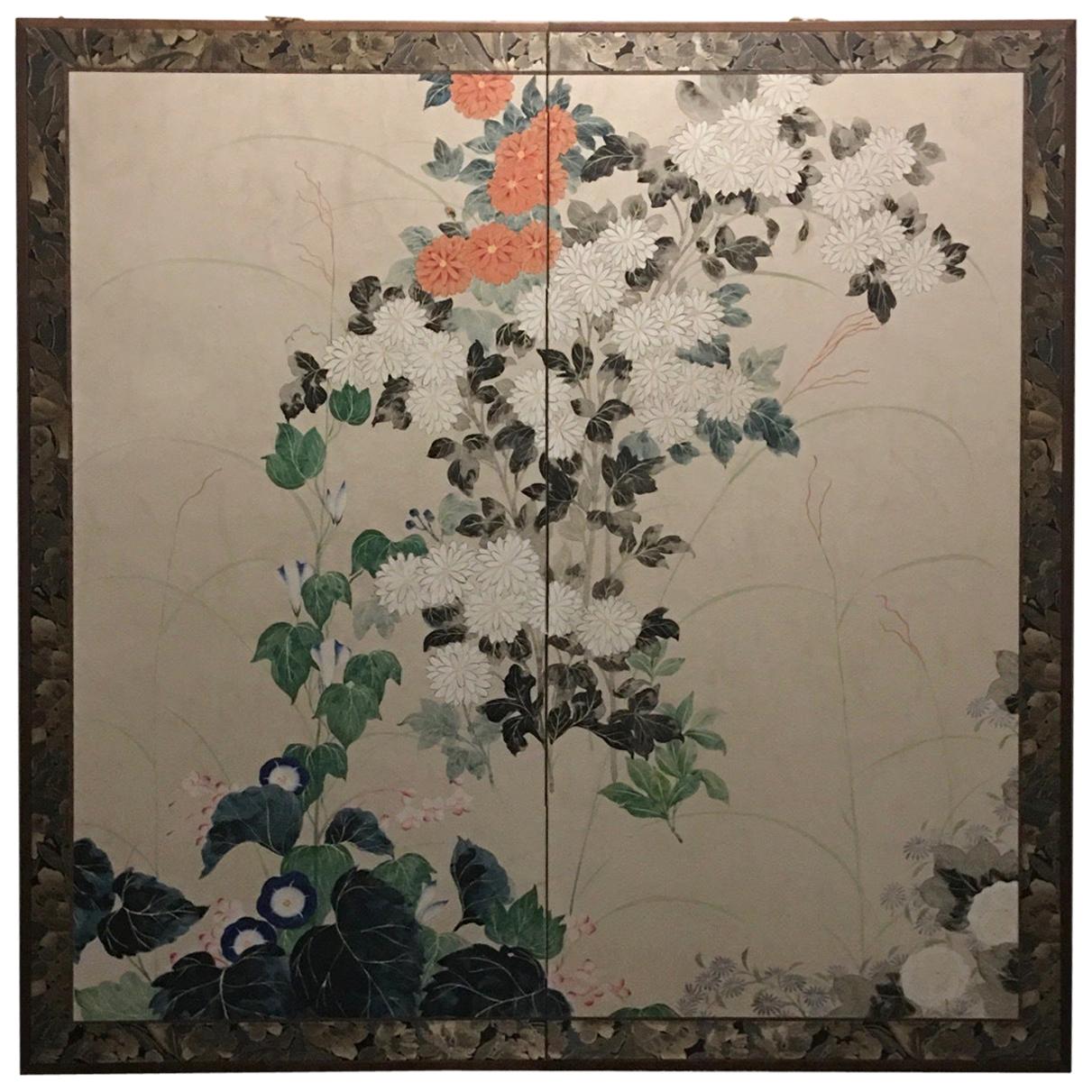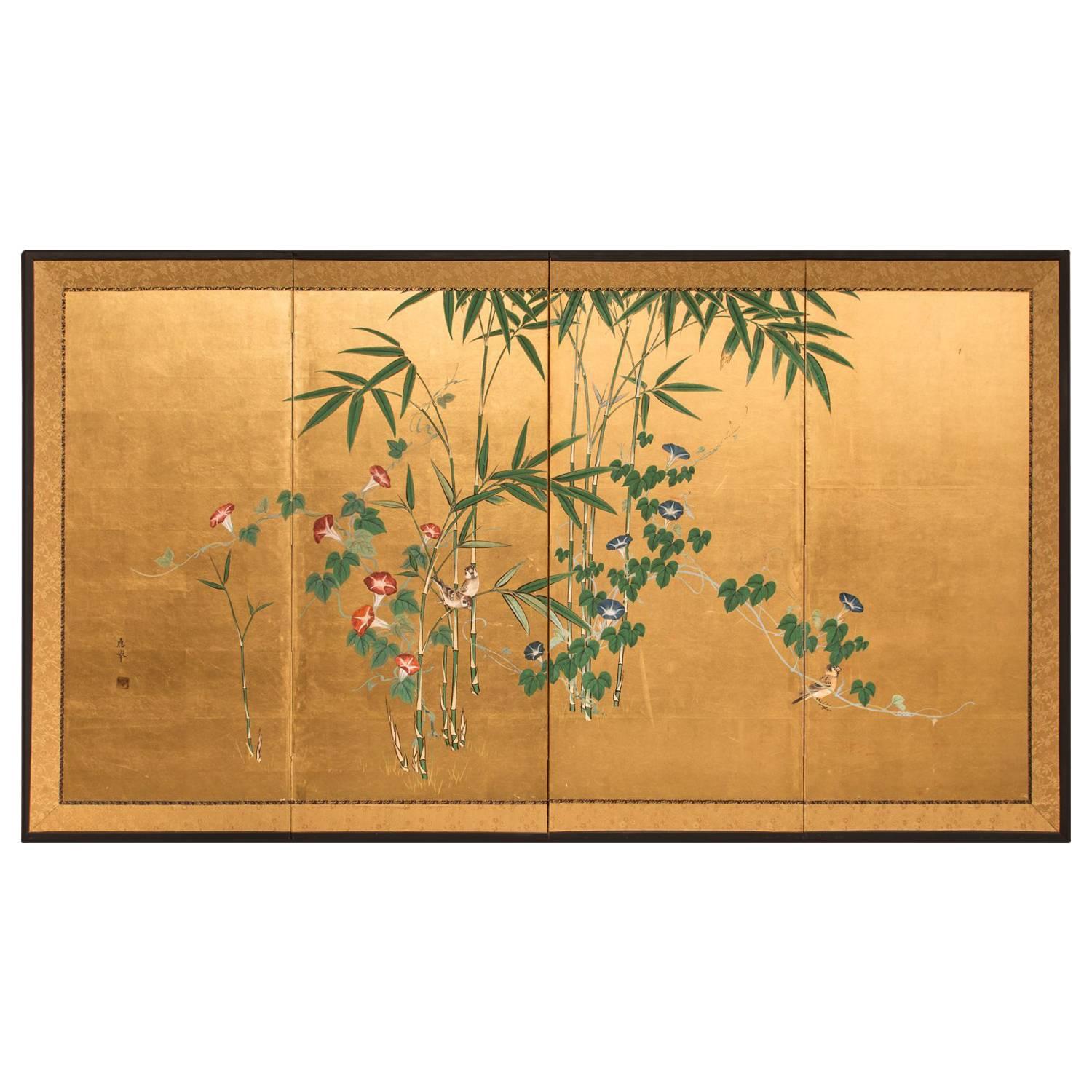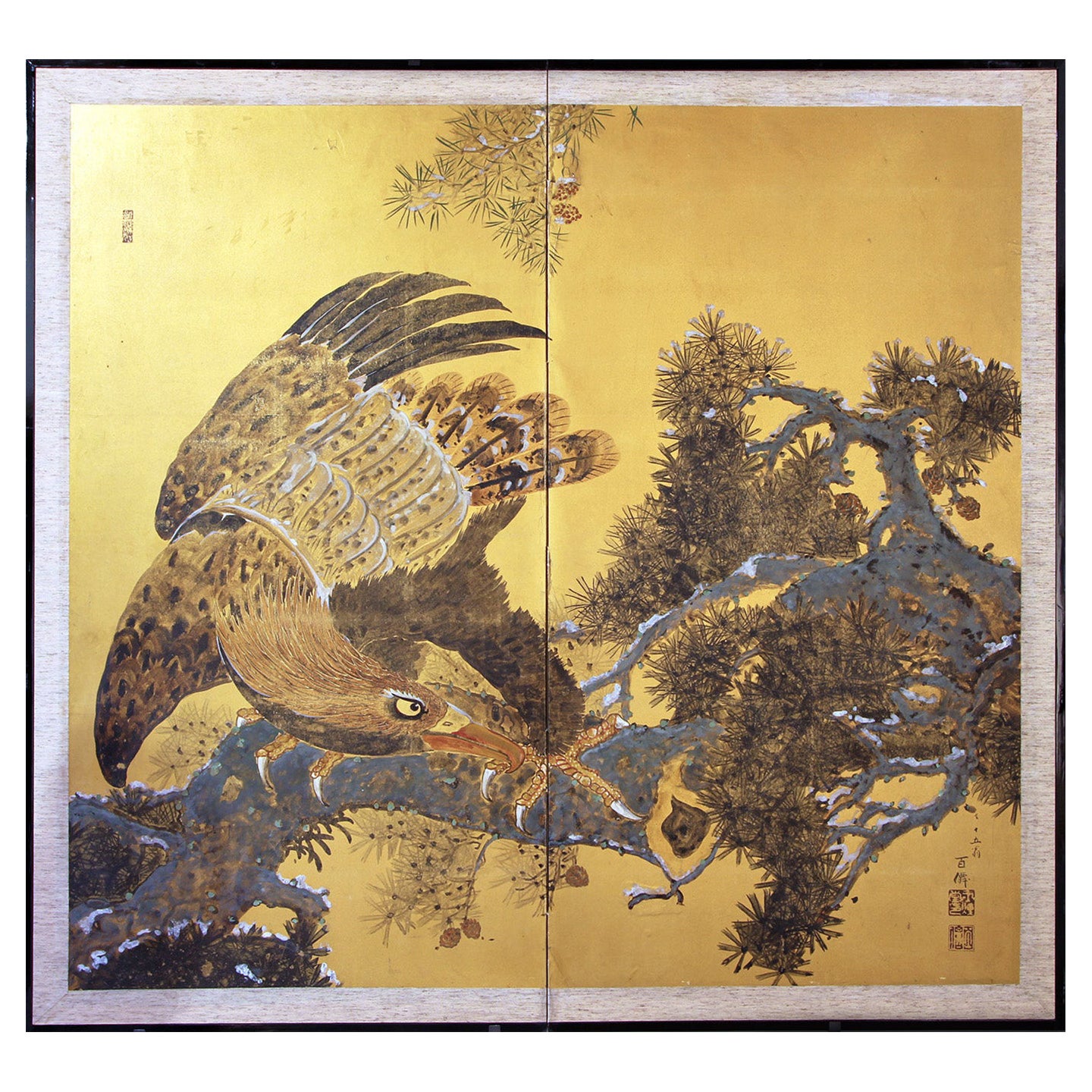Items Similar to Japanese Two-Panel Screen, Cockscomb and Morning Glories
Want more images or videos?
Request additional images or videos from the seller
1 of 10
Japanese Two-Panel Screen, Cockscomb and Morning Glories
About the Item
Nihonga style, finely painted spring flowers with a dragonfly detail in mineral pigments on silk. Signed and sealed: "Seichu". Real name: Aoki Keinosuke (1891-1973), born in Kyoto, studied Shijo school of painting under Takeuchi Seiho. Graduated from Kyoto Bijutsu Kogei Gakkou and Kyoto Kaiga Senmon Gakkou. Exhibited at Teiten 7, 8, 9, 11, 14, 15; Shin-bunten 2, 3, 6; Nitten 4, 13. Lacquer framed individual panels with cotton webbing hinges (as pictured).
- Dimensions:Height: 67.5 in (171.45 cm)Width: 69 in (175.26 cm)Depth: 2 in (5.08 cm)
- Materials and Techniques:
- Place of Origin:
- Period:
- Date of Manufacture:circa 1925
- Condition:Details on request.
- Seller Location:Hudson, NY
- Reference Number:
About the Seller
5.0
Recognized Seller
These prestigious sellers are industry leaders and represent the highest echelon for item quality and design.
Established in 1971
1stDibs seller since 2008
151 sales on 1stDibs
Typical response time: 4 hours
Associations
The Art and Antique Dealers League of AmericaAntiques Associations Members
- ShippingRetrieving quote...Ships From: Hudson, NY
- Return PolicyThis item cannot be returned.
More From This SellerView All
- Japanese Two Panel Screen Akita Puppies and Morning GloriesLocated in Hudson, NYOn gold leaf.Category
Antique Late 19th Century Japanese Paintings and Screens
MaterialsPaper
- Japanese Four-Panel Screen, Young Bamboo and Morning GloryLocated in Hudson, NYMineral pigments on gold, signature reads: Okyo.Category
Early 20th Century Japanese Paintings and Screens
- Japanese Six Panel Screen, Morning Glories on a Bamboo ArborLocated in Hudson, NYVery early painting of a gold arbor with morning glories, the mulberry paper almost appears polished. Please see close-up photos to show staining from use over the many years (on the...Category
Antique Early 17th Century Japanese Paintings and Screens
MaterialsPaper
- Japanese Two Panel Screen, TurkeysLocated in Hudson, NYMineral pigments on silk, mounted on a gold panel, in silk border. Signature and seal read: Yoho.Category
Early 20th Century Japanese Paintings and Screens
MaterialsSilk
- Japanese Two Panel Screen, HollyhocksLocated in Hudson, NYEdo period (18th century) furosaki screen (tea screen), with seal of the artist: Jakyu. Korin School painting, employing Kenzan style of split image. (see "Morning Glories" Metropoli...Category
Antique 18th Century Japanese Edo Paintings and Screens
MaterialsWood, Silk, Paper
- Japanese Two Panel Screen, ChrysanthemumsLocated in Hudson, NYBeautiful white chrysanthemums are emphasized by heavy gold on a soft floral landscape, while gold clouds create a striking and dream-like floral scene. Gold leaf and gofun with min...Category
Antique Early 18th Century Japanese Paintings and Screens
MaterialsGold, Gold Leaf
You May Also Like
- Japanese Two-Panel Folding Screen with Chrysanthemums and Morning GloriesLocated in New York, NYJapanese Meiji/Taisho period two panel folding screen richly painted on Mulberry paper and depicting chrysanthemums and morning glories on a ivory background. The piece is framed by ...Category
Vintage 1910s Japanese Meiji Paintings and Screens
MaterialsWood, Paper
- Japanese screen two-panelBy Japanese StudioLocated in Brescia, ITEagle on a pine branch with traces of white snow. A rare subject for this mid-century two-panel screen, painted in mineral pigments on gilded paper. The screen is a nice size and is ...Category
20th Century Japanese Showa Paintings and Screens
MaterialsPaper
- Japanese Edo Period Two-Panel ScreenLocated in Stamford, CTA Japanese Edo Period two panel folding screen with white and brown hawks of ink and color on paper.Category
Antique Mid-19th Century Japanese Edo Paintings and Screens
MaterialsPaper
- Japanese Meiji Period Two Panel ScreenLocated in Stamford, CTJapanese Meiji Period (1868-1912) two-panel painted screen with various Tale of Genji scenes - ink, colors and gold leaf on paper.Category
Antique 1870s Japanese Paintings and Screens
MaterialsPaper
- Japanese Meiji Two Panel Screen Geese and ReedsLocated in Rio Vista, CAFantastic Japanese late Meiji period two-panel byobu screen by Hashimoto Koshu. The large screen features two white geese amid brightly colored reeds. The symbolism of geese and reeds was introduced to Japan from China in the 13th century. This was a popular subject for Japanese zen artists of the period. Beautifully crafted with exceptional brush strokes and details. Made with natural pigments in dramatic vivid colors of white, pink, and mint green on a silk background of gilt. Circa 1900 with artist seal on bottom right corner. Koshu studied Western art under...Category
20th Century Japanese Meiji Paintings and Screens
MaterialsSilk, Wood, Paper
- Edo, Japanese Screen Two Panels Rinpa SchoolBy Japanese StudioLocated in Brescia, ITLandscape with Flowers and Bamboo by an 18th century painter of the Rinpa school, two panels painted in ink on gold leaf and vegetable paper. The flowers...Category
Antique 18th Century Japanese Edo Paintings and Screens
MaterialsGold Leaf
Recently Viewed
View AllMore Ways To Browse
Circa Screen
Japanese Cotton
Japanese Painted Panels
Japanese Painted Screen
Japanese Paint Screen
Asian Panel And Screen Paintings
Silk Painted Screen
20th Japanese Screen
20th Century Japanese Screen
20th Century Japanese Screens
Silk Screens Framed
Japanese Screen Framed
Japanese Screen Two
Two Panel Screen
Japanese Silk Screens
Panel Lacquered Screen
Silk Panel Screen
Japanese Two Panel





